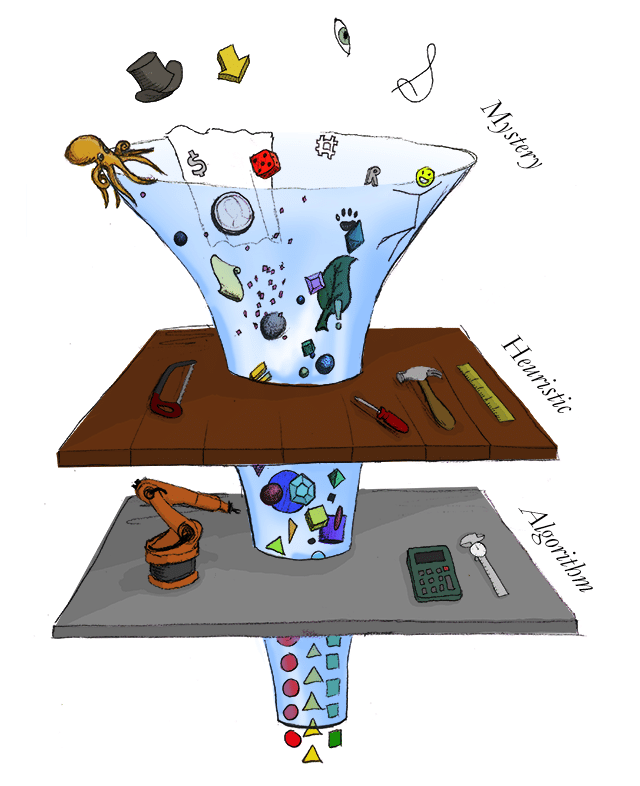When I started Atomic Object with my co-founder in 2001, I followed my instincts and engineering training, as I had no formal business education and very little business experience. I wish I’d known about the knowledge funnel back then. Reading about this simple model in Roger Martin’s book, The Design of Business, was an “ah ha!” moment; he explained so well, and so simply, the process we more or less bumbled our way through in getting Atomic up and running. If understanding is a prerequisite to solving any problem, Martin contributes a simple, visual model and vocabulary to discuss and therefore increase the odds of creating value and improving your business.
The knowledge funnel has three stages: mystery, heuristic, and algorithm.
Mysteries
Mysteries are problems to be solved or new pleasures to be created. From a business perspective, mysteries worth solving are those that people care enough about to pay for. Mysteries are things like “how can I help golfers improve their swing?”, “how do conference organizers deliver value to sponsors?”, or “why do most people drink bad beer?”.
An entrepreneur wrestles with a mystery, perhaps applying a formal technique like design thinking, or a more ad-hoc, intuitive approach. While researching, exploring, and thinking, she eventually makes an abductive leap that leads to a heuristic that may solve the mystery. Abduction is a form of logic, like deduction and induction, but unlike those more familiar forms, it seeks to predict the future, rather than draw conclusions from the past. As such, it isn’t air-tight and guaranteed to produce a successful result. Abduction is about validity (what might be) versus reliability (what is proven).
Heuristics
Heuristics are rules-of-thumb that generally work to solve a problem. They work well enough to be given a name and to build a process around. Once an entrepreneur has heuristics sufficient to solve a mystery that matters to people, she can build a company and deliver value to customers. Heuristics can be refined and improved over time as the company gains experience, learns from experiments, and refines its understanding of the mystery.
Algorithms
Some companies reach a point where their heuristics have become so well-defined, predictable, and effective that they become algorithms. Algorithms produce the same result, every time, for a given input. Making hamburgers at McDonald’s is an algorithm; cooking steaks at home, on the grill, runs on heuristics.
Companies that have developed algorithms to solve the problems of their customers have the potential to scale up dramatically. Martin uses the example of the McDonald brothers solving the mystery of what people in 1950’s Southern California wanted to eat while away from home (hamburgers, fries, shakes, served quickly), and Ray Kroc turning their heuristic solution into rigorous algorithms that could be successfully applied on a grand scale.
Some businesses never reach the algorithm stage. Software design and development firms are good examples of these. My company, Atomic Object, has many heuristics we apply very successfully to our projects (one-week iterations, pair programming, test-driven development, fixed budget engagements, human-centered design practices, etc). But these heuristics require a great deal of experience and adaptation on each project — no one knows how to turn software product development into a set of algorithms that could be predictably applied on a mass scale.
The table below shows three examples of mysteries, observations, abductions and heuristics. Notice that:
- None of the abductions are guaranteed to explain the observations; there are other possible explanations.
- There could be many heuristics created from each abduction.
- Building a product or service around a good heuristic is still a lot of work.
- Building a company to support the product or service is its own huge challenge.
| Mystery | Observation | Abduction | Heuristic/Algorithm |
|---|---|---|---|
| How do you improve the quality of software? | Software typically has many simple bugs. | Writing test software to prove your software behaves as expected will improve quality. | TDD patterns, tools, approaches. |
| What do working parents need help with in a car? | Parent drivers can’t tell if their babies are ok in the backseat and may be distracted. | Parents who can see their babies will be less distracted. | Create a product for cars which has a video camera in the headrest showing the backset view projected on the windshield. |
| Can we sell music more efficiently? | Teenagers don’t care about the CD, and frequently skip songs when listening. | Downloading music makes CDs unnecessary, unbundles albums. | Create an online store for browsing and buying DRM-protected music, one song at a time. |
Conclusion
The knowledge funnel isn’t just useful for start-ups. In my next post I’ll look at the two main modes companies operate in (exploration and exploitation) and describe the risk that success creates in established companies.
- Attention: Spending Your Most Valuable Currency - February 10, 2022
- Slicing the Revenue Pie in a Multi-Stakeholder Company - July 30, 2021
- Commercial versus Existential Purpose - July 19, 2021
- How I Misunderstood Mentorship and Benefited Anyway - June 16, 2021
- Sabbath Sundays and Slow Mondays - June 4, 2021
